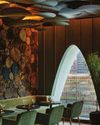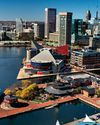The Artist's Way

IN THE 1830S, at the tail end of Japan's flourishing Edo Period, two artists set out to document one of the country's great roads. Crossing seven modern-day prefectures and the snowy crags of the Japanese Alps, this thoroughfare, the Nakasendo, connected the imperial capital of Kyoto with the cultural capital of Edo (now Tokyo).
The Nakasendo had been in use for centuries by the time the printmaker Keisai Eisen was commissioned to create woodblocks of the 69 rest stations along the route-a task later taken over by Utagawa Hiroshige, the acknowledged master of the form. The Nakasendō's busy towns provided ample material for their work in the ukiyo-e genre, which documented leisurely pursuits and landscapes during the last centuries of Japan's isolation from international affairs. (Ukiyo-e means, roughly, "pictures of a floating world.") Within decades of the publication of the Sixty-Nine Stations of the Nakasendo, the Edo Period would come to an end, Japan would begin to industrialize and Westernize, and the road would never see as many travelers again.
Still, parts of the Nakasendo remain intact. Last spring, three college friends and I decided to take our annual meetup a little farther afield, booking a self-guided itinerary with Walk Japan that would follow one of the more complete sections of the old road-a string of 17th-century towns in the Kiso Valley, which straddles the Gifu and Nagano prefectures. The Nakasendo at its full extent stretched 330 miles and would have taken the average traveler two or three weeks of intense legwork; our three days of walking would be easier, and much more luxurious, with our bags transported separately by car. But I hoped I would be able to pause every so often and hold up my phone to line up one of Eisen's or Hiroshige's prints with the real thing.
This story is from the {{IssueName}} edition of {{MagazineName}}.
Start your 7-day Magzter GOLD free trial to access thousands of curated premium stories, and 9,000+ magazines and newspapers.
Already a subscriber ? Sign In
This story is from the {{IssueName}} edition of {{MagazineName}}.
Start your 7-day Magzter GOLD free trial to access thousands of curated premium stories, and 9,000+ magazines and newspapers.
Already a subscriber? Sign In

DENVER POPULUS
The 13-story, wedge-shaped Populus (below) cuts a striking figure in Denver.

TOKYO JANU TOKYO
Aman's new spin-off brand, Janu, seeks to maintain a high level of design and service at a lower price point than its ultra-luxe sibling.

SPAIN Dunas de Formentera
Within an hour of arriving at Dunas de Formentera (below), a 45-room retreat on the smallest of Spain's Balearic Islands, I had ditched my shoes to walk the undulating dunes.

NEW ORLEANS The Celestine
In the heart of the French Quarter, this 18th-century building—once the hotel where Tennessee Williams wrote A Streetcar Named Desire—has reopened as the Celestine (left), a 10-room hideaway with a sumptuous cocktail bar, Peychaud’s.

TUSCANY BY THE SEA
The coast of Tuscany—once considered wild and remote— remains an insider secret.

NICE, FRANCE HOTEL DU COUVENT, A LUXURY COLLECTION HOTEL
Hidden away in Nice's Old Town, Hôtel du Couvent (above) is the chic property this coastal city craved.

A JOURNEY FOR THE SENSES
Drawing from nature and Mayan culture, Waldorf Astoria Riviera Maya invites you to experience Cancun through an entirely different lens.

ARGENTINA OVO Patagonia
The journey to this collection of four egg-shaped capsules suspended 885 feet up a cliff is an adventure in itself.

BETTER THAN A PIED-A-TERRE
This addition to one of New York's top hotels is perfectly on trend.

Charmed City
With new design hotels and a high-low culinary renaissance, Baltimore is getting its groove back.
